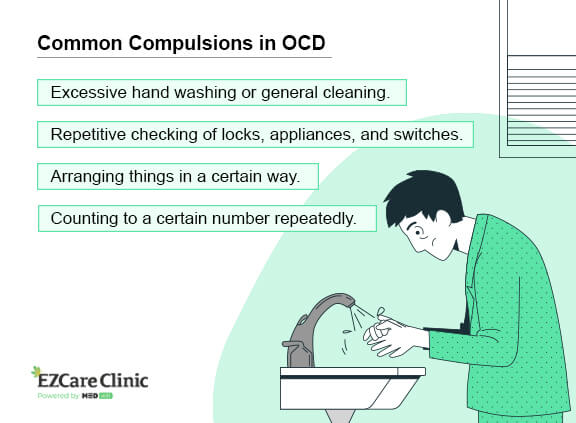The present focus on mental health has had many people interact with different terms describing various disorders. While the new attention and desire to understand and address mental health issues is welcome, there is also the unwanted effect of people misusing the terms and self-diagnosing themselves with conditions they do not have.
OCD and anxiety are two mental health conditions often mistaken for one another, and insufficient familiarity with both can lead to the wrong diagnosis. Here is a look at these two conditions and their clear differences.
OCD and anxiety have a lot in common. Check your symptoms and connect with a therapist to get a legit diagnosis.
Is OCD an Anxiety Disorder?
A frequently asked question is: is OCD a form of anxiety? The answer is no, though that only changed recently in 2013. The earlier editions of the Diagnostic and Statistical Manual of Mental Disorders (DSM) had OCD under the anxiety disorders category along with GAD and others. However, new research has shown that the neurological causes of OCD and anxiety are different. Also, OCD and associated conditions have significant commonalities which separate them from anxiety disorders. So, in the latest edition of DSM-5, OCD is now grouped under the Obsessive-Compulsive and Related Conditions section, where it is along with related conditions like:
- Hoarding disorder.
- Body dysmorphic disorder.
- Trichotillomania.
OCD Vs. Anxiety
OCD and generalized anxiety disorder share some symptoms, key among them being the presence of distressing thoughts, which can affect an individual’s ability to function properly. However, three significant differences help separate the two conditions.
Manifestation
OCD and GAD manifest themselves in thoughts and behave differently. The nature of thoughts differs with GAD thoughts classified as worry and OCD thoughts classified as an obsession. People suffering from GAD worry about real-life issues only that it is at such an intense degree that it is excessive and uncontrollable. They also have a penchant for thinking of the worst possible outcome, distorting their thinking and decision-making. Issues of worry range from major issues like health, relationships, and finances to minor ones like work presentations and other everyday stressors others would not treat so intensely.
Thoughts in OCD, on the other hand, focus on less common issues and are often unrealistic but extremely distressing. People with OCD may recognize that the thoughts are unreasonable—but they are too intrusive to get rid of using reasoning.

They include:
- An extreme obsession with symmetry, order, and precision.
- Distressing sexual images, ideas, and thoughts.
- Recurrent and intrusive thoughts of numbers, words, images, or sounds.
- Fear of contamination from people or the environment.
In terms of behavior, GAD and OCD differ by the presence of compulsions. OCD has compulsions, while GAD has none. Compulsions are repetitive physical or mental acts that people with OCD use to cope with their obsessions. They feel driven to do this behavior to find relief from their obsessions, believing that doing so will prevent the feared outcome. The compulsions could be related to the obsession or unrelated. Common compulsions include:
- Ritualized/excessive hand washing, general cleaning, toileting, showering, or teeth brushing.
- Arranging things in a certain way.
- Always seeking reassurance and approval.
- Repetitive checking of locks, appliances, and switches.
- Counting to a certain number repeatedly.
Your condition can be treated—EZCare doctors are ready to examine your symptoms and offer a personalized treatment plan.
Diagnosis
The diagnosis of the two conditions differs. According to the DSM-5, the criteria for assessing GAD is the presence of excessive worry and anxiety on a variety of issues, events, or activities that often happens for a minimum of 6 months and is very challenging to control. On the other hand, the diagnosis of OCD requires the manifestation of obsessions and/or compulsions that take much time, up to an hour a day, which result in significant stress impairing work and one’s social life.
Do I Have OCD or Anxiety?
The only way of telling if one has OCD or anxiety is to focus on the symptoms, with the main differentiation being the presence of obsessions and compulsions in OCD. The line between OCD and anxiety is often blurred, especially when the obsessions are not so clear-cut or fully formed. In some instances, the individual obsessions could be misconstrued as good behavior, or in the case of mental compulsions, they may not be seen.
In such cases, the difference between the two conditions is a matter of degree and content. GAD sources or worry and concern are usually common issues from relationships to the economy. On the other hand, OCD issues tend to be out of touch with reality and crazier compared to GAD ones or how things happen.
In terms of degree, the obsessive thoughts are also much more forceful and intrusive in OCD than in GAD. They are more frequent and are often unwanted, causing much distress since they are often opposite to how the patient views themselves. For example, an individual could be obsessing over causing harm to himself or others when they view themselves as non-violent, which goes against their values. Further, you may have OCD if you find that such thoughts cause a pronounced detrimental effect on your daily life. Ultimately, only a proper test by a trained mental health doctor will provide the ultimate diagnosis.

Can You Have OCD and Anxiety?
Yes, it is possible to have both OCD and anxiety either happening concurrently or one condition developing later in life after one has been diagnosed with the other. Such occurrences are more common than one might expect.
Correct understanding of the differences between the two conditions is important for the patient and the therapist as it helps a patient note any difference in the presentation of their condition. The psychiatrist can know when the two conditions are present and prescribe the right treatment plan.
Conclusion
OCD and anxiety are both mental disorders that can be debilitating and make life a struggle for patients with them. Worse, their similarities can easily be mistaken for one another. However, they have significant differences, and the fifth edition of the DSM no longer lists OCD under anxiety disorders. This distinction is vital in prescribing the correct and effective treatment for each disorder.
Whether one has GAD or OCD, it is important to seek the help of a qualified therapist experienced in treating both conditions to get the correct diagnosis. Only a proper screening and several tests by a qualified therapist can determine the exact condition you are facing. Effective treatment helps one build better coping mechanisms and overcome whatever drives their fears, compulsions, and anxieties.
Sources
- Obsessiveâcompulsive disorder comorbidity: clinical assessment and therapeutic implications. (2011)
Source link







